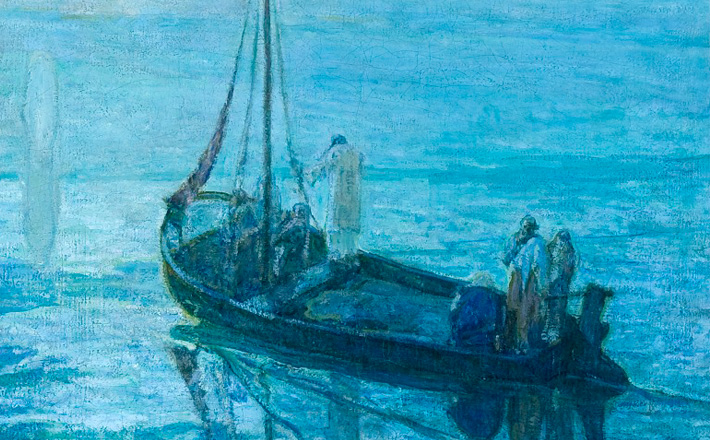Commentary on Matthew 14:22-33
There is an old hymn that testifies, “Jesus calls us o’er the tumult of our life’s wild, restless sea.”
In the Gospel reading this week, Jesus indeed calls to his disciples in the midst of the wild and restless sea1, but he is not beckoning them away from the storm. Instead, his voice calls them into the tumult.
The text says that Jesus made the disciples get into the boat (14:22). A better translation of this main verb would be “to force” or “to compel.” Jesus did not give the disciples a choice. He compelled them to get into the boat and to leave him alone with the crowds.
Why did he not have the disciples stay and help him with these crowds? After all, the multitude is huge. There are 5,000 men and probably twice as many women and children (14:21). They followed Jesus out to this lonely place (14:13). It was the disciples who wanted Jesus to get rid of the crowds before the great miracle of the feeding (14:15). Only after feeding this multitude does Jesus send everyone away: the crowds and the disciples.
It is not insignificant that Jesus retreats to the mountain while he has sent his disciples out into the raging chaos of the sea. The mountain in Matthew’s Gospel is a place for encountering God and hearing the proclamation of God’s glorious kingdom (e.g., 5:1-7:29; 17:1-8). In Moses-like fashion, Jesus proves that he is both the leader of the crowds and the intercessor to the divine. He climbs alone to a mountain for his rendezvous with the Father.
Jesus stays on the mountain to pray. Twice the writer states that Jesus is by himself (verse 23). While Jesus is alone conversing with the Father, the disciples find themselves in a life-threatening situation.
The disciples are many stadia from the land, and the boat is being beaten — or, more literally, being tormented — by the waves. The situation is reminiscent of Jesus’ calming of the sea in Matthew 8:23-27. In that story, Jesus led the disciples into the boat and stayed with them, even though he was asleep. When the storm arose and the waves covered the boat, the disciples cried out, “Save, Lord; we are perishing” (8:25). Jesus questions, “Why are you afraid, O men of little faith?” Then, he rebukes the wind, and the story ends with the disciples marveling, “What sort of man is this, that even the winds and sea obey him?” (8:27).
In our passage this week, though, the disciples do not have the luxury of awaking Jesus. Jesus is not there.
The disciples have been struggling to keep afloat for a while. The text says that it is not until the fourth watch of the night that Jesus decides to come to them in the middle of the sea. Thus, it is the early morning hours (3 a.m. to 6 a.m.), while it is still dark, that Jesus makes his appearance.
The disciples, though, do not initially recognize Jesus in the midst of the chaos. They have been alone with the threatening waves for hours. They are probably tired from being up all night. In the midst of this crisis when their energy reserves are spent, Jesus reveals himself to them.
In this exhausted state with the roar of the waves and the spray of the sea drenching their boat, they mistake the Lord of creation for a phantom. Given the common perception of the sea as the locus of evil and chaos, it is hard to blame them for initially mistaking the figure of Jesus for a specter of death. After all, it is they who have rowed into the middle of evil’s realm, and the waves are indeed attacking them.
Over their cries of fear, Jesus calls to them, “Take heart, it is I; have no fear” (15:27). Jesus reveals himself — not simply as Jesus, their teacher, but as “I AM.” A more literal translation of this sentence would be, “Take heart, I am, do not be afraid.” This self-revelation is a disclosure of Jesus’ source of power. For Matthew’s Jewish Christian audience, Jesus’ words echo the divine name.
Jesus’ self-revelation moves beyond his words. His actions are also revealing. According to Job 9:8, God alone stretched out the heavens and trampled the waves of the Sea. In Psalm 89:9, the psalmist exalts the Lord, “You rule over the surging sea; when its waves mount up, you still them.” In the midst of the sea’s churning, Jesus does what only God can do. This is a theophany.
The last time Jesus revealed his power over the chaos of the sea he did so within the confines of the boat. Even then, his power confounded the disciples. Now, he is displaying his power in the death-defying stunt of walking on the sea.
When confronted with the inexplicable reality of a God who controls chaos with his toes, Peter does the inexplicable: he asks to meet Jesus in the tumult. The text does not say that Jesus calmed the seas to make Peter’s steps easier. In fact, it is the wind that frightens Peter and causes him to sink. It was only Jesus’ call that made it possible for Peter to make any strides in the first place.
At this point in our narrative, the story sounds remarkably like the previous miracle on the sea. There is a cry for the Lord’s salvation followed by Jesus’ question of faith, “O man of little faith, why did you doubt?” (verses 30-31). This week’s text, however, ends by answering the question posed by the first narrative. The first time Jesus calmed the sea, the disciples were left wondering who Jesus is. This calming of the sea ends with a declaration, “Truly you are the Son of God.” (14:33).
In Matthew’s Gospel, this story is meant to reveal who Jesus is. But that revelation is only possible in the midst of the chaos. If Jesus had not forced the disciples to embark on this uncertain journey, they would have missed the opportunity to see God revealed in their midst.
Notes:
1 Cecil Frances Alexander (1818-1895) included in The Methodist Hymnal: Official Hymnal of the Methodist Church (Nashville: The Methodist Publishing House, 1966).


August 10, 2014